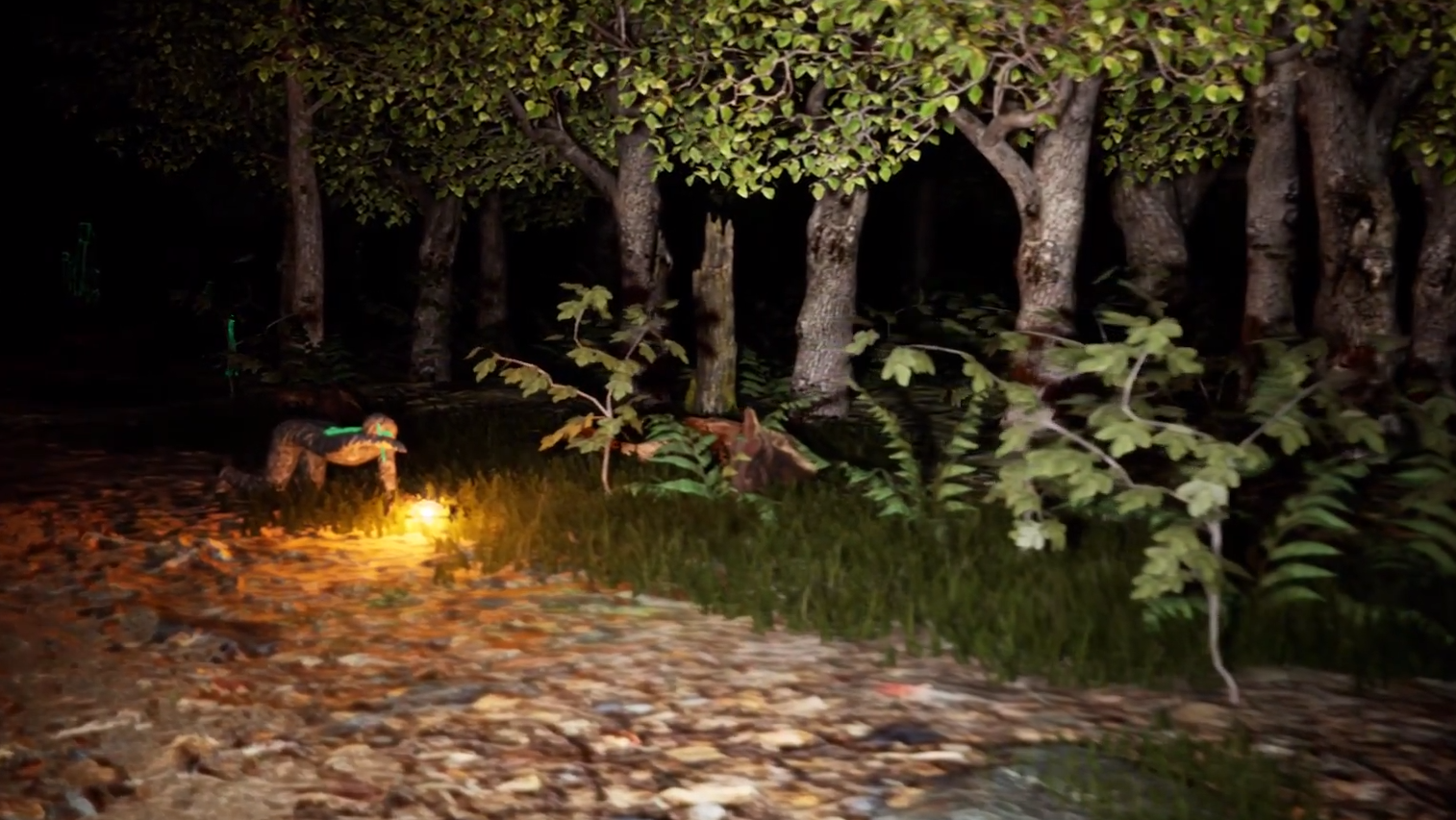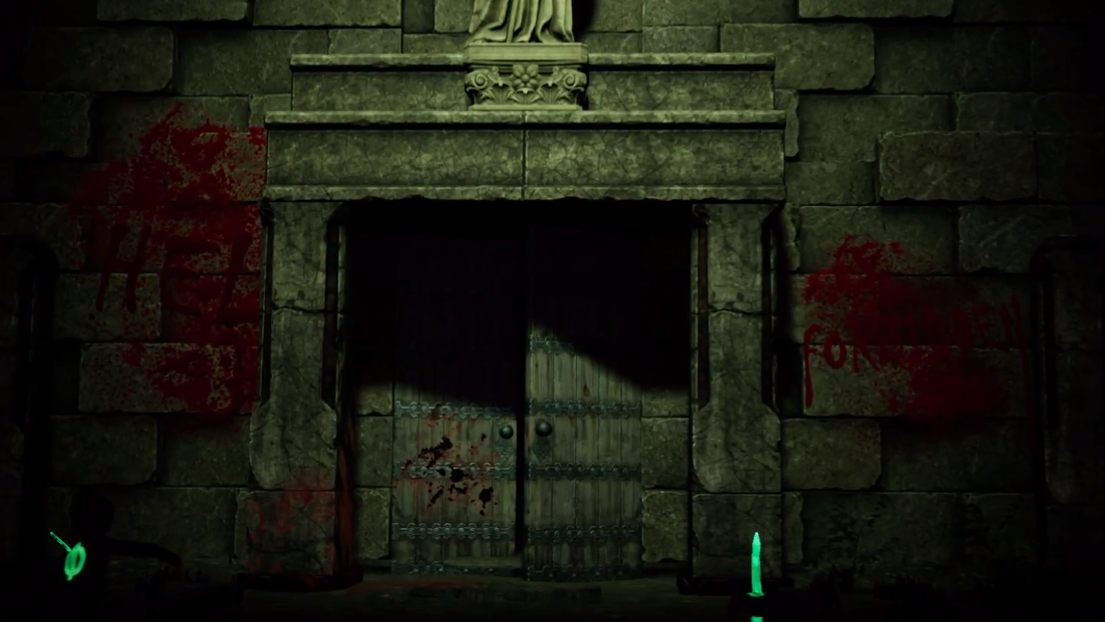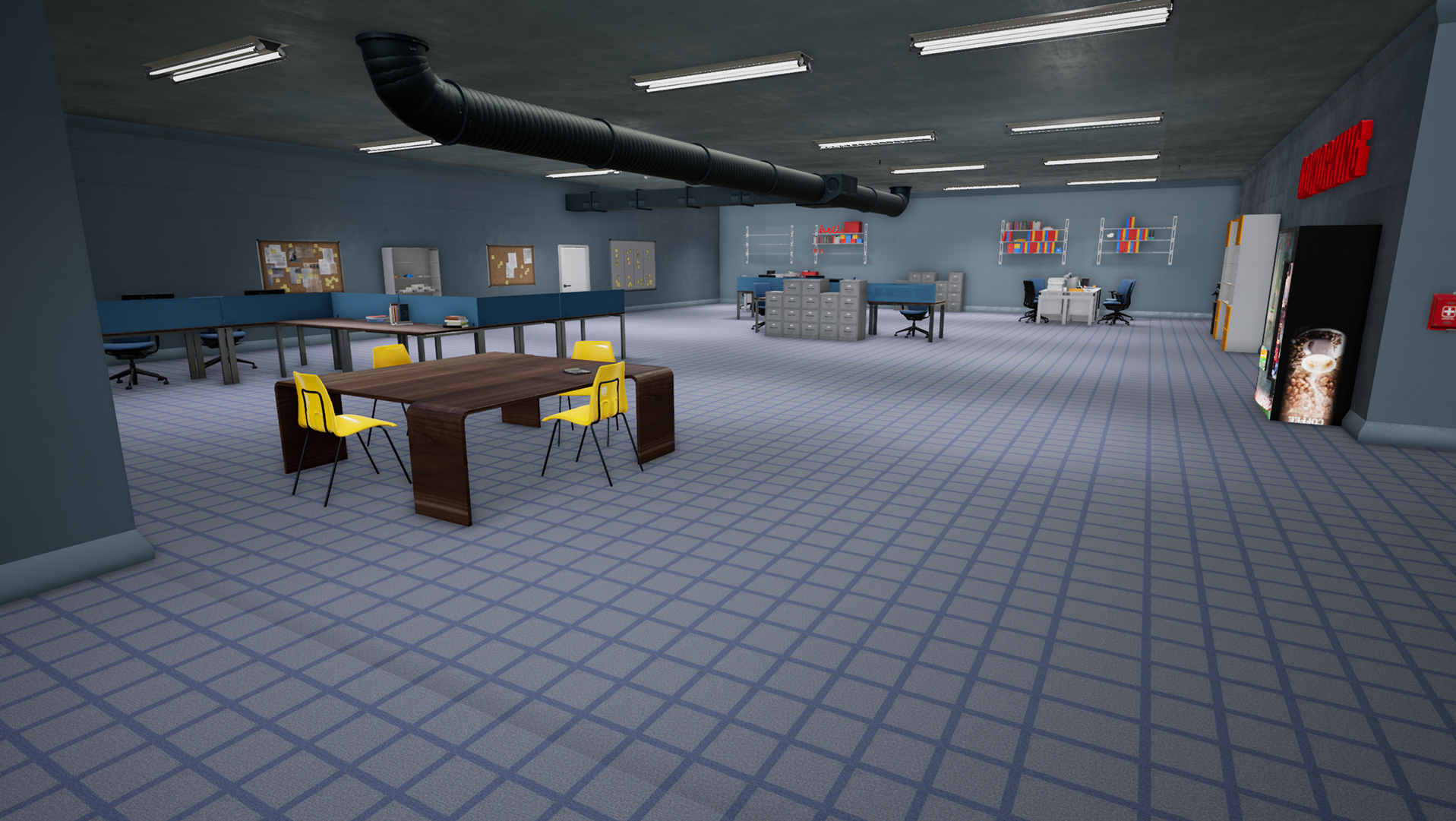Role: Area Designer
Team Size: 100+ People
Time: 4 Years
Engine: Unreal Engine 5 (Initially Unreal Engine 4)
What is an Area Designer
It's a studio specific title so I'd like to take a moment and break down what the responsibilities were: Quest Designer, Level Designer, Narrative Technical Designer, and occasionally Writer. Job is to champion and implement the entire experience of sidequests, Points of Interest, interactive vignette content and hard-load dungeons. We act as a sort of creative producer, getting every member of the team in line with what the goal of a space or an experience is. It's a combination of low level leadership, along with acting as the primary or sole implementor of content.
My work was dedicated to creating interesting stories for the player to participate in, engaging and novel level layouts, and setup combat and reward pacing for those experiences. I was also dedicating additional time to generate new basic gameplay proposals such as our Treasure Map system, and proposing unique weapons for the player to find that leaned on our existing library. The easiest comparison I can make is to working as a Dungeon Master with a very complex digital toolkit, but additionally with a strong emphasis on owning the level experience.
For Avowed I worked on several quests (listed at the end of the document) but championed 2-3 from concept to completion, mostly off of single sentence proposals handed to me by leadership. I also created a number of quest-less explorable spaces (Pargrun Caches, God totem Shrines, Outdoor POIs, and other miscellaneous findable content). I also handled the blockout and revision passes of major crit-path dungeon spaces.
I'll be focusing on 2 quests I worked on in particular: Heart of Valor & Courier, both featured in the Shatterscarp Region of the game. I'll include a version of those single sentence proposals below. Below those is a brief write up on one of my levels "The Lava Tubes" that acted as the finale to our game's penultimate region, and an additional write up on Warden's Warding.
I've also included some images for Level Design layout examples, borrowed from collaborator's artstations.
Tools:
- Unreal Engine 4 & 5 (Project converted part way through)
- Unreal Engine Blueprint Scripting
- Internal Narrative Scripting Tools (Similar to Articy Draft)
- Confluence
- Jira (Cloud)
- Landscaping Tools (Unreal Editor)
- AirTable
- Perforce
- Unreal Game Sync
- Photoshop CC
- Discord
- Microsoft Teams
- Outlook
- Pen & Paper designs
The amount of work I did on Avowed was pretty staggering. We were a mid-sized team of about 70 developers trying to make a massive parkour heavy role-playing adventure.
At least 3 quests were developed by me personally in full (Heart of Valor, The Wasteland Courier, Warden's Warding) while I also handled work on half a dozen more either in the initial development or after content was orphaned (Memory of the Deep, Fire in The Mines, One Last Drink, Debt of Blood, Missing Rangers, Steel Resolve, Don't Look Down) for the sake of brevity I'll be focusing on just two: Heart of Valor and The Wasteland Courier (Valor & Courier, as I tend to shorthand).
I have included additional quests and levels I worked on below those sections but could not cover everything I worked on succinctly. I am happy to discuss more details on other content on request.
Process
Avowed was built over a period of four years with content teams facing frequent reshuffles to compensate for needs and shifting priorities. My basic pipeline went as follows:
1. Proposal: Leadership would ask for/hand the team a proposal to develop for a space/quest/POI. I would take that proposal and flesh it out into a short paragraph with the intent of creating a more cohesive story/adventure out of the premise.
2. I would begin writing a document breaking down the intent of the content, it's narrative premise, quest branches (if any) and creating a basic 2D top-down of the locations involved in that content. Reviews and feedback would follow, leading to some major or minor changes.
3. I would then begin the blockout (level design), framework (quest design) and gameplay (traps, dialogue triggers, AI scripting, and combat encounters) for the quest in weekly or bi-weekly rounds. I would also be expected to handle setting up some of if not all of the conversation files and gameplay scripting. Character behavior schedules and banter timings would be hand-scripted by me using a combination of variables and conditional gates to ensure as few reference chains as possible and improve performance. Occasionally I would be asked to move onto something else for a few weeks and act as a consultant to give Environment Art space to flesh out the levels and replace blockout elements with props and shippable assets.
4. As the quest's basic flow was solidified, I would then start handling Quest permutations. What if the player visited the dungeonspace first? What if they only spoke to one of the npcs but not the other? Some of our characters, such as the local sheriff (Tira Nui Hajime) were being used in multiple quests, and required several instances to be simultaneously handled at once in order to be save/load compliant and flexible in the face of edge-cases.
5. Finally, reactivity. Some of our quests had 2-3 stages of reactivity that had to be handled with a combination of calendar bound events in blueprint and consideration for average player pacing.
During each step of the process, I also took time to meet with artists, writers, and gameplay engineers to ensure we had the budget (assets, dialogue lines, and gameplay elements) to produce the content to a shippable quality. We also made significant time for feedback from members on the team and outside the team. These check-ins and tests became especially important as there were periods where Area Design was asked to work by themselves, or prepare for handoff moments to the environment art team. Code changes, and things break, and knowing how and why helped us improve all content. Occasionally, this process would help us identify major gaps in our pipeline and toolkit, such as our unfortunately outdated trap manager system, and creating a more consistent framework for handling reactive events.
Alpha & Post Launch
In the last year of development we transitioned into Alpha. During Alpha period my duties were primarily to handle bugs and improve performance. I was also responsible for breaking up scripted content into discrete buckets, as larger reference chains caused hitches in framerate as well as potentially exposed us to bugs (never fun when an NPC is loaded in before the ground's collision is and they fall into the void!). As our combat was late to come online, many of the designers on the team transitioned to encounter design while I primarily spearheaded efforts to lower our bug count.
This process continued into post-launch where I would regularly clean up our bug queue, relying on my experience with debug logs and our error messages to target fixes that worked for our game. Occasionally these changes would be large, rebuilding entire pieces of content I was unfamiliar with.
This process continued into post-launch where I would regularly clean up our bug queue, relying on my experience with debug logs and our error messages to target fixes that worked for our game. Occasionally these changes would be large, rebuilding entire pieces of content I was unfamiliar with.
Quests: Heart of Valor & The wasteland Courier
These are more elaborate write ups of Heart of Valor and The Wasteland Courier. Other Level and Quest Design work follows.
Heart of Valor
Elevator Statement
A chair-bound local legend asks the Envoy (player character) to retrieve a cherished relic from their past, unintentionally dividing the last remnants of a family, exposing the complexities of legacies, and asking the player what it means to give someone the right to die on their own terms. In a time of crisis, is it more important to champion the truth or let people live with a lie that helps them survive?
Initial Request
A guy in town wants you to go get him a thing from a dungeon.
Summary:
Heart of Valor is a quest where the player (at the behest of a local legend named Keipo) visits a nearby dungeon and explores it in order to retrieve the petrified heart of a massive Leviathan (Whale Monster) but discovers that the truth behind its hunt is more complicated than the story that inspires the local community. Players are asked to consider whether the town can survive the truth, as well as whether or not Keipo's only living family member and caretaker, Chiko, could handle the tragedy of losing their uncle.
Valor included comedic trap premises and scripted moments to make the location feel unique even after 40+ hours of the player's adventure.
By leaning on the premise of a retired adventurer with far too much free time, I was able to narratively justify creating traps in a grounded Fantasy IP that always needs to clearly show "Who built this and how?" even with grander scale and magical story as ambience. How does an adventurer in retirement deal with thieves constantly trying to steal from their trophy room? Thankfully, the answer was to speak directly to the player and their instincts.
Before leaving Obsidian, it was clear this quest became a guiding light for future work in it's layout and in how it handled a complex emotional story that gave players validating agency in how to end it.
Level Design: Building a dungeon
The dungeon featured complicated trap arrangements using the our existing toolkit, that inspired the team to build out more elaborate scenarios in the last year or two of development. Some of these include a timed flamethrower hallway, a corridor of pendulum blades that emerged from the ground below a "laser grid" of trip wires, and a setup I like to refer to as a "Reading Check" where a quick scan will encourage the player to pull the wrong lever to open a sealed doorway. I was delighted that the enthusiasm poured into designing and building the space was felt by players vividly. Some of these traps were planned, while others were added as the blockout evolved.
While I no longer have access to the original files, here is an example of how the original 2D topdowns looked. The intent of using lines to connect rooms instead of defined hallways was to ensure art had as much freedom as possible while making them aware of some of the design's needs. This map ended up being combined to create the opening section of the dungeon, with the log trap parkour route sitting above a combat arena that helped make the space feel more alive (The undead and man-eating spiders tend to be pretty grumpy when you turn on loud machinery in their den).
The dungeon had a unique opportunity with it's layout. By leaning on the narrative of an erratic adventuring legend's enthusiasm for challenging the next generation, I was able to justify wackier ideas that I would have felt awkward making elsewhere. Signs that attempt to trick you, log traps you have to leap across, and an amount of corpses that earned one hallway the nickname "The Gore-idor" made sure the dungeon felt fun and engaging, even if the backstory was tragic and observant. I wanted the space to feel like exploring a retired dad's garage workshop, filled with half finished gadgets, piles of junk and exposed craftsmanship. I think this balance helped honor all types of players who visited the Sand Sea Ruins.
As our NPCs had no sense of "travel" I hand scripted NPCs arriving at and leaving locations. Chiko, as an example, would show up at the exit to the dungeon before you left, implying they had followed you out of town, and then after their relevant conversation, I simulated them exiting the dungeon with a combination of patrols, animations, and stasis.
As our NPCs had no sense of "travel" I hand scripted NPCs arriving at and leaving locations. Chiko, as an example, would show up at the exit to the dungeon before you left, implying they had followed you out of town, and then after their relevant conversation, I simulated them exiting the dungeon with a combination of patrols, animations, and stasis.
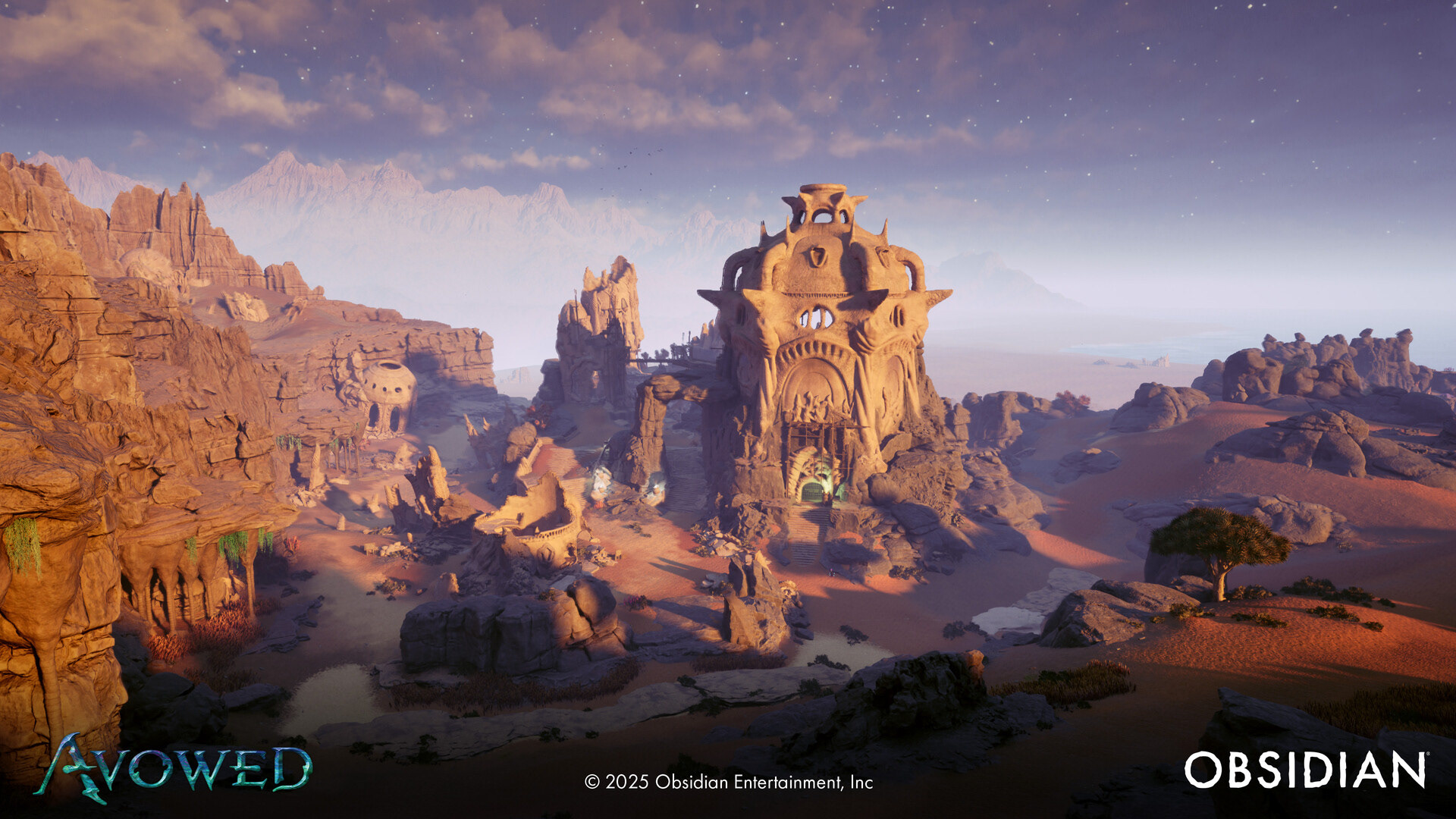
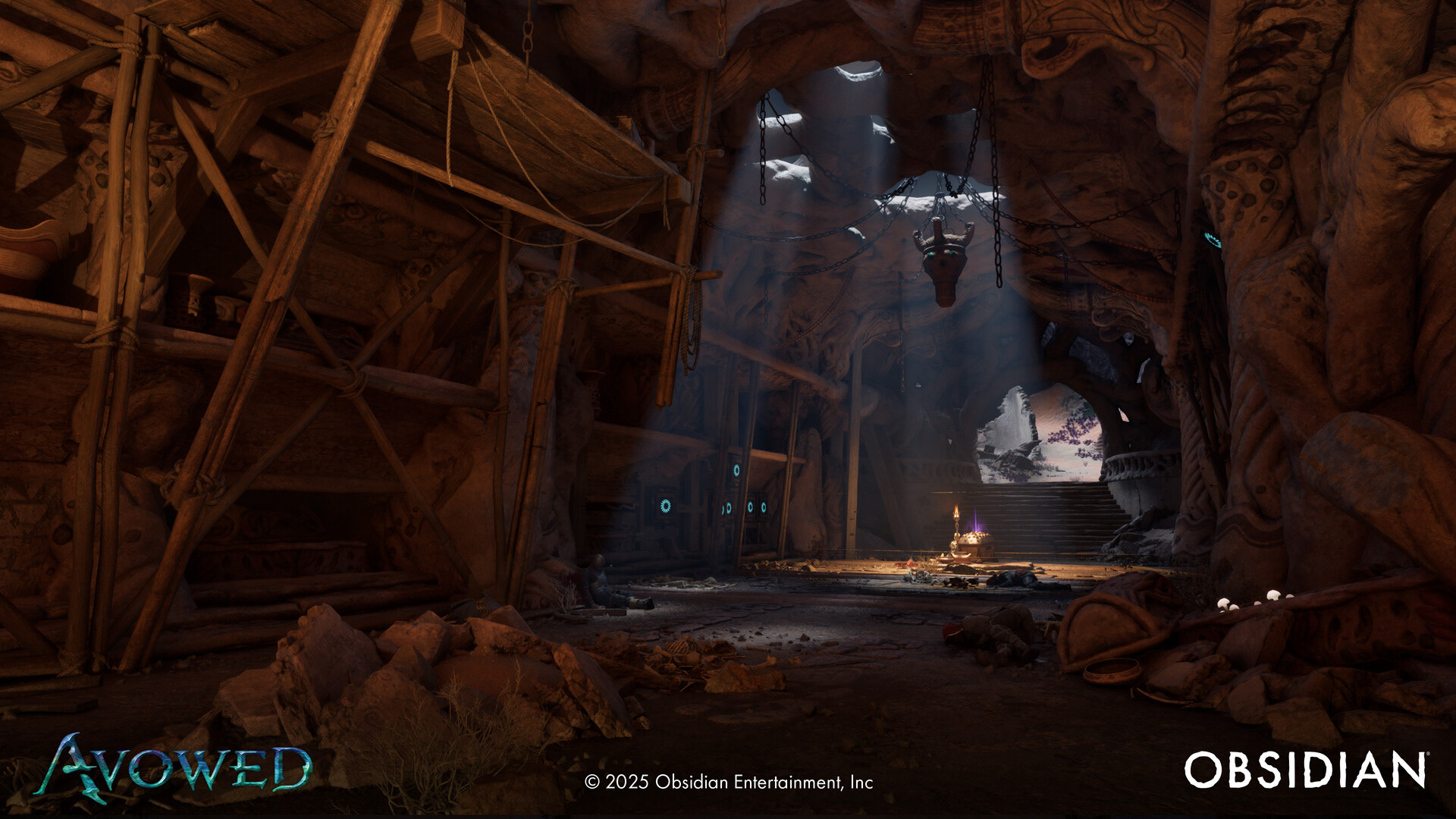
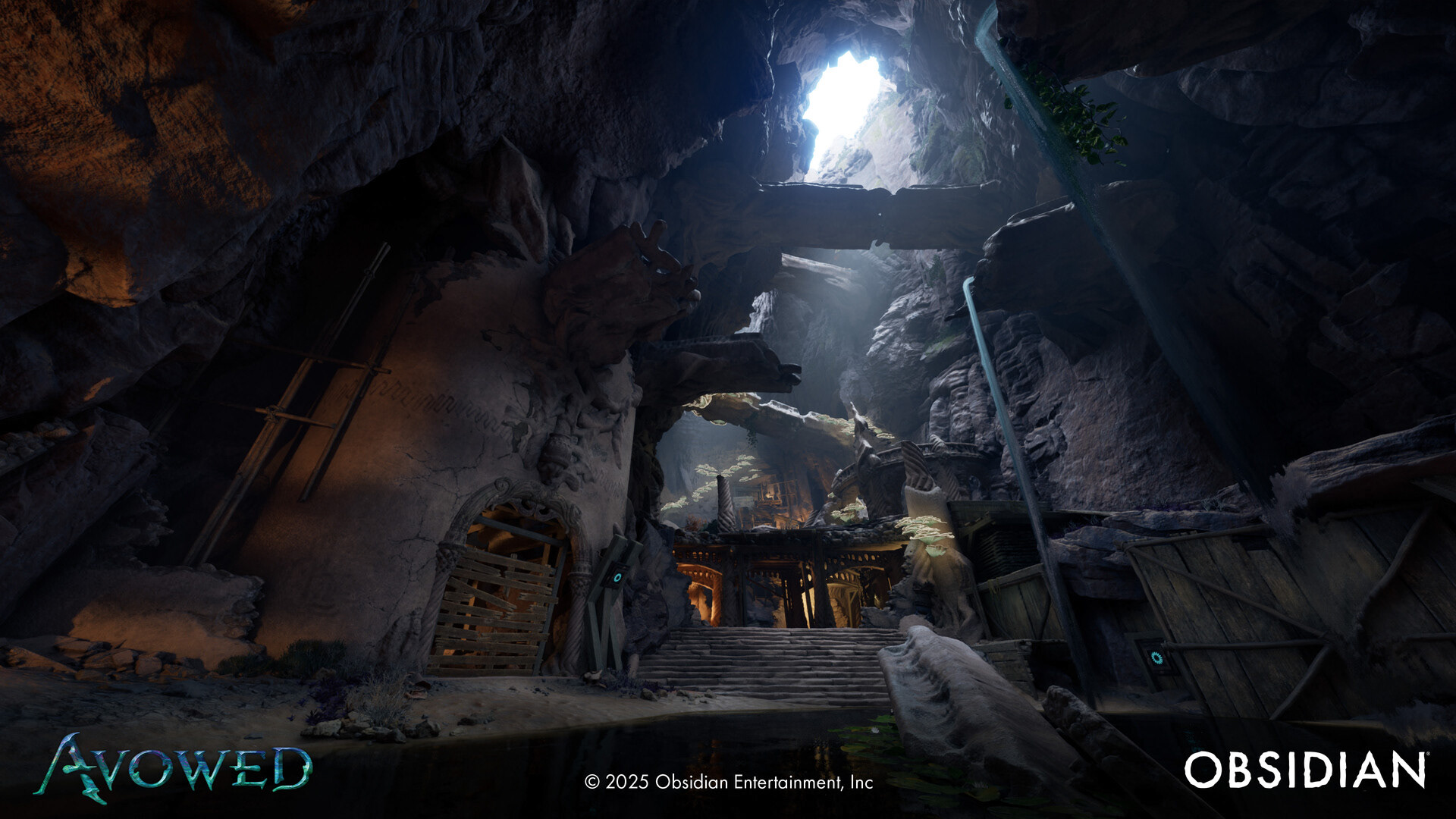
Images of the Sand Sea Ruins dungeon's exterior, Gore-idor hallway, and a larger combat arena.)
(images taken by talented Environment Artist and Worldbuilder David Gigliello!)
(images taken by talented Environment Artist and Worldbuilder David Gigliello!)
QUEST DESIGN: Endings Squared+
As a Quest, Heart of Valor presented a real challenge: There are technically two intertwined but wholly separate aspects to the quests you can find. The main path requires you to find Keipo's Leviathan Heart and bring it back to him but there is also a secret journal that can be found, potentially unlocking an additional series of endings where you reveal he did not slay the Leviathan alone and has been hiding the death of his partner (presumed missing) for decades now. Players needed to be able to visit the dungeon without the quest, or complete the quest with that information being optional.
The quest also featured one of the earliest examples of "Multi-step reactivity" where the player could eavesdrop on Chiko and Kepo talking about the quest privately in their home after the quest had ended, and also paying off Keipo's central premise: the fear he might be dying and that it is likely the dreamscourge. Giving him the heart to end his life will prevent him from turning into a monster and killing Chiko (who manages to hold their own long enough to put their uncle's dreamthrall down as well). The town's reaction to that news as well as the memorial to the slain leviathan also reflect your choices, either mourning the loss of a local legend and their family, only the dead legend, or whether the plaque near the leviathan skull now commemorates Umpara, the partner Keipo lost on the hunt. Unfortunately this presented a real flaw in our scripting system but thankfully I was working with an incredible team and was able to help prototype and ship a system that tied into our existing but untouched calendar system using delayed event calls to trigger later moments in the story. This ended up being a massive boon on the quest and was injected into content across the project to add some semblance of world dynamism. Up until Valor, there was no way to run a stopwatch of any kind and trigger events after a couple of seconds, days, or hours. We ended up making over a hundred of them to handle everything from hints in puzzles to characters being killed off as consequence for player decisions.
From a more philosophical view one of the reasons I landed on this approach of a multi-faceted ending was to avoid something called the Good Bad Compromise problem RPGs tend to have. A lot of players will summarize quest choices, especially in Obsidian titles by saying they feature a Good Choice (do the nice thing and get the big reward for more work), the Bad Choice (short term convenience or personal gain) or the Compromise Choice (you try to find a way to appease both sides to a problem). I don't want players to feel like I'm handing them a pop quiz about finding the right option, I think that pulls them out of the experience and into the same realm where they're worried about their doctor's appointment next week, and the messages they're not checking on their phone. Anxious players feel pressured to find a good choice while power gamers will default to whatever a walkthrough tells them. By at least making the narrative more nuanced, and spacing out the actual consequences, I hoped to ensure Valor does not fall into this trap.
Narrative Design: Putting the Heart in Valor
Emotional Exploration was as important as the Gameplay Exploration
Valor was the more emotional of the two quests I ended up developing from conception through release, which was a challenge as two of the writers on this content ended up leaving the studio before the quest had reached it's Beta phase. A lot of the reactivity and narrative writing towards the end of the quest had to be handled by me directly or in conjunction with writers who had no time to familiarize themselves with the content.
Heart of Valor is a story about the legacies we leave behind and asks the player to weight the value of those legacies against the value of truth. It's a story about a family that loves one another but have nothing in common, with Chiko's struggle of watching a loved one die something we all deal with eventually. It's a caretaker's dilemma that doesn't demand attention but gives the player ample opportunity to recognize it. It's tragic but something I consider important. As the son of immigrants with a radically different life and culture to grow up in than my parents did, I put a lot of that experience of disconnect with the previous generation into the quest's story. The way that people can love each other even if they struggle to speak a common language, resisting the desire to ask them to change for you, loving them even if it feels impossible at times.
The narrative designer who wrote this quest's first drafts, Lis Moberly, also put their feelings as a young caretaker for an elderly family member into this narrative, and we bonded over trying to make something that was difficult to answer and avoided prescribing a solution on the player.
There are no monsters in this story, only circumstance and the ugly things it does to us to help us protect the people we love. You fight monsters in the dungeon (spiders, undead remnants of previous thieves, and the Heart you're asked to retrieve was taken from a giant whale monster) but there was no easy fingers to point. Giving players the opportunity to judge Keipo as a monster was important to me, even if I personally did not agree with it. Umpara made a choice, and ultimately honoring them as someone with agency in their own demise felt more appropriate than treating them like a victim. I wanted players to focus on the experience in front of them instead of a classic good-guy/bad-guy setup. Umpara, and the tragedy of the legendary hunt, are not even relevant pieces of content for the player to explore but I wanted it to feel cohesive with the whole story if you did find it. I wanted Keipo to be mysterious and questionably senile but also a tragic figure. It is the reason why you can find a teapot, two cups, and a ring called Umpara's promise in view of the long-ruined boat in the same chamber you find the dehydrated leviathan's heart. I like to imagine he spent many nights there, talking to Umpara about how much they managed to inspire the town. I think she would have been proud of Keipo.
I'm proud of the amount of shipped dialogue and text I produced for this quest including a line where the player challenges Keipo for obfuscating the truth about the death of his partner on the hunt for the Leviathan. Pedestals and hero worship can be tragic things, and I wanted to ensure that players could connect with that blatantly while respecting their ability to digest the nuance.
"From the moment I stepped off that boat, I stopped being Keipo the man. I became the leviathan slayer."
Player Reaction:
Post-launch one of the more popular trends on the game's subreddit was to post clips of a simple trap setup I made involving a swinging log they'd seen dozens of times at this point, a simple sign they could read "Do not pull this lever under any circumstance", and a mysteriously tempting lever beside it. Even in development it was considered such a charming moment that it ended up earning it's own Achievement:
"That Sign Can't Stop Me Because I Can't Read."
A quote from one of the early players of the game was: "It's clear to me whoever built this space had a lot of fun making it". I think those sorts of tangible feelings can make even the simplest game a lifelong memory and turn casual players into lifelong fans.
Post-launch, we also noticed a different but wonderful response from role-players who engaged with the story.
They found the narrative cathartic, especially handling a topic as difficult as suicide without downplaying it's impact. The rift between Chiko and Keipo was something many players could connect to, and cried when they noticed that, had they not let Keipo die, Chiko would be found dead only a day later.
They found the narrative cathartic, especially handling a topic as difficult as suicide without downplaying it's impact. The rift between Chiko and Keipo was something many players could connect to, and cried when they noticed that, had they not let Keipo die, Chiko would be found dead only a day later.

A funny trap can go a long way

The level was a huge hit with players

The emotional weight of the quest made some people cry
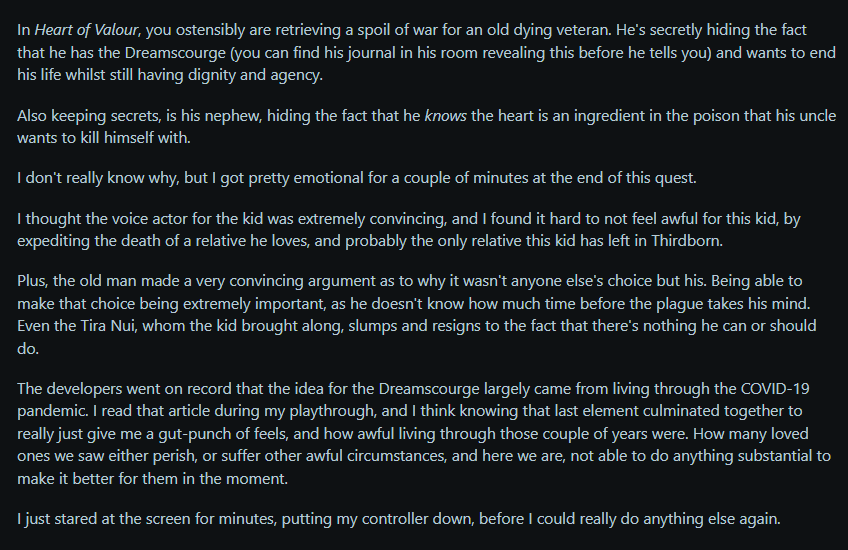
Cliche to say it but this was the player reaction that lived in my head while working on Heart of Valor. I am thankful the message carried through so vividly.
The Wasteland Courier
Elevator statement
A merchant in Thirdborn asks the player to act as a courier and pick up a mysterious package from their supplier just outside of town, following handpainted arrows.
Initial Request
- "Call this number for a good time".
- A quest where you do drugs.
Summary:
A merchant in town named Daiko asks you to pick up a mysterious package from his supplier outside of town. While he seems unwilling to tell you what it is, following his directions you find yourself meeting his brother, caught in the middle of a sibling spat over some mushrooms harvested off of the corpses of dreamthralls. They're hoping the mushrooms are psychedelics and will get people high. Unfortunately the operation's a bust and Aiko dies from injuries received prior to your involvement. The player has an opportunity to turn the twin elves in (one alive, one dead) to an orlan acting as the town's Tira Nui (Sheriff), only to find out he's the older brother of these bumbling baffoons. It's a funny, light quest that refreshes the player compared to the more dour stories littered across the desert.
Surprisingly, The Wasteland Courier was one of the first instances of a "Comedy from the beginning" piece of content and it's development ended up causing comedic ripple effects throughout the rest of the game. Up until that point on the project the game had felt extremely dour tone that was missing a human quality. Working together with an extremely talented writer & narrative designer (Katie Tenney), we were able to flesh this adventure out into something that ended up being a team favorite. It was a real opportunity for the two of us to take our existing rapport and shared sense of humor and bring it to an IP we both love.
While I was not the writer for this quest I was given agency by the narrative designer to input my own words and thoughts into some of the dialogue and we would occasionally meet to "act out" some of the story beats we wanted to happen.
Quest Design: Linear Doesn't Mean Boring
Courier is a linear experience adventure with a choice at the very end: Do you hand over the drugs to Daiko or turn him into the cops for all the trouble he's caused. The goal was not to make something as elaborate as Heart of Valor, but to flesh out the region's story with lighter content while onboarding a narrative designer I think is wickedly funny.
The major considerations for the quest are mostly in the reactivity, from Aiko's corpse getting a proper burial where he died after the quest ends, to Daiko getting kicked out of town, to an angry mob that can form based on your choices on this and other content.
The main challenges here were in the post-quest mob story, as well as handling the law enforcement character that appears in this quest, Heart of Valor, and is critical to several other pieces of region content. I was directly responsible for the stasis and handling of these characters, often finding flaws in our pipeline that helped us catch significantly more issues early and reduce the amount of bugs before ship.
Post-Quest Mob: If you decide to turn Daiko in to the cops at the end of the quest line, and you blow up the godless ruins nearby (a major critpath decision), he'll be waiting for you along with his dead brother's two remaining friends (Shizu and Kauka) at the end of the region story. Along with the two quest NPCs from Don't Look Down if they're still alive, acting as an angry mob of locals over how you've ruined everyone's lives with your meddling.
If you talk them down Daiko can be found as a merchant in the following region, and the other four characters join in the final fight in Paradis that acts as the game's finale.
(The above image is borrowed from worldbuilder Seth May. Lighting by Adriana Catarino.)
Level Design: Following Arrows
Right from the get-go, the feeling I went for with the level design was of an investigator crawling over obstacles in town to follow a trail that is far, far longer than it needs to be. Initially this was an unpopular choice, people didn't know why I wanted to waste the player's time like that, but it sets a stage and a mood that were vital to putting players onboard with the content. The feedback on it was overwhelmingly positive once I got to work putting it together.
I figured not every player would need these arrows for direction, and took a lot of feedback on where the arrows should be placed, wanting the characters to define the story and not my author voice. These are bumbling fools trying to make a living in the wasteland and playing at criminal masterminds.
Once you've found graffiti in town that leads to the actual drop off point, I played with the existing region's level design in another way that really delighted me as a designer. The player is guided to turn right back outside of town, re-viewing the landscape they've already explored from a new perspective and revealing an absolutely comical series of blatantly obvious arrows that were just out of sight on your initial approach to the town. To me, this was an opportunity for storytelling but also a practical approach. I was not given a large level design budget for this quest (actually the smallest at the time) and was asked to find ways to cut back on the art budget whenever possible. The quest's flow had to make do with both the town's existing layout and a mostly solidified overlands exploration experience. The meeting spot in the wasteland (where you pick up the package) was the only spot that got an actual budget. Everything else was built into existing formations and landmasses. It was a thrilling challenge for a level designer.
Narrative Design: Making Drugs Funny
One of the rules the narrative designer and I landed on early was "This cannot be a joke about drug trips". I did not want it to feel like something out of POSTAL or an earlier title from the 90s. To me this was a multifaceted decision. For starters, we did not have a budget for a crazy out there drug trip experience reminiscent of the content in Oblivion's Shivering Isles DLC or the infamous "chicken" trip in The Witcher 3. I loved those experiences, and so did the team! Unfortunately, supporting something like that would have been a massive scope grenade to make and the game's final product would have suffered for it. Secondly, it was unclear at the time how culture was shifting around psychedelics, with several states in the U.S.A. (where we are based) having active legal discussions on whether things like psilocybin should have some sort of practical use in medicine. Thirdly, the team is based in the States but our audience is global. I wanted to avoid creating something that could date the game and alienate players from different backgrounds.
Instead we focused on the ways that people would try to adapt to an evolving crisis. There are now mushroom zombies walking around the landscape and muttering in riddles. We figured the logical step was to ask how a normal person would try to make a living in that new reality. While this was certainly a challenge, I managed to rally the team around this low-budget and low-risk version of the quest that ensured we were not succumbing to scope-creep.
Instead we focused on the ways that people would try to adapt to an evolving crisis. There are now mushroom zombies walking around the landscape and muttering in riddles. We figured the logical step was to ask how a normal person would try to make a living in that new reality. While this was certainly a challenge, I managed to rally the team around this low-budget and low-risk version of the quest that ensured we were not succumbing to scope-creep.
To play into the idea of taking the drugs, I setup a series of stages across Shatterscarp (accounting primarily for fast travel or players choosing to go their own way) where the party asked to try the drugs with you. I liked the idea of teens trying something dumb based on a rumor they heard "Hey I hear if you eat a green apple and a red apple you can get high!" and the amusing disappointment that followed it. To ensure the player felt like the joke wasn't being played on them, the player could also lie to Daiko upon delivering the package, claiming they saw one of several drug trips that are fun nods to games in Obsidian's past.
Player Reactions:
In general the reception to the quest was very positive, and players seemed to connect with the humor. I think the smartest move we made was focusing on ensuring the player felt like they were playing the straight man on this adventure, and giving them a chance to call out the nonsense without relying on meta humor.
Other Design Work
Galawain's Tusks (GT)
While working on another region of the game called Emerald Stair, I was sprinting ahead. So much so that I ended up outpacing our schedule and was asked to shift over to another strike team dealing with scope concerns and staff departures. It was a major shift going from a swampy overgrown forest to an expansive volcanic region. GT was planned to feature two major dungeons, both on the crit path, and The Lava Tubes would be the climax of the experience. It was an enormous challenge to develop with how early into the project we were, and at several points was likely a razor's edge away from the chopping block.


Some screenshots of the layout work in the Solace Keep Lava Tubes, one of my largest dungeons in the game.
(The above images are borrowed from worldbuilder Seth May. Lighting by Adriana Catarino.)
Level Design: The Solace Keep Lava Tubes
The Lava Tubes, sitting underneath Solace Keep via a hidden door in the forge area, was one of the earliest dungeons developed exclusively for Avowed, about a year and a half into my time at Obsidian, so the team needed an early win to make it clear we could build this game.
Initially this layout was a source of conflict and concern. Our project stakeholders were nervous. It was huge, unwieldy, easy to break the level design thanks to some of our movement options, and the production team was worried it would require dozens of new assets to bring to final ship. It was also causing issues in our ability to work as a team, as art did not feel they could finish this space but couldn't imagine any way to fix it quickly. It needed to tell the story of the godless who came before, of the society who lived in the keep above, and present an engaging parkour challenge without requiring any new assets.
Most projects would have scrapped it and started over. I was then given the space and asked to try to make it work. I had two weeks, and one world builder to work with. By the end we made something that inspired dungeons across the project.
During a period where the original senior design member had to take medical leave, they requested that I specifically handle this content. At the time I was still an associate but I am forever thankful they did. In a short 2 week turn around, I was able to completely reformat the space using existing aspects and rooms, clarifying the purpose of spaces and the player's pathways without a massively expensive rescope
Pretty much everything you see here is a result of the changes I made along with the fantastic worldbuilder Seth May. It was one of my favorite pieces of work on the project, and managed to be the largest low-cost dungeon in the game.
During a period where the original senior design member had to take medical leave, they requested that I specifically handle this content. At the time I was still an associate but I am forever thankful they did. In a short 2 week turn around, I was able to completely reformat the space using existing aspects and rooms, clarifying the purpose of spaces and the player's pathways without a massively expensive rescope
Pretty much everything you see here is a result of the changes I made along with the fantastic worldbuilder Seth May. It was one of my favorite pieces of work on the project, and managed to be the largest low-cost dungeon in the game.
QUEST & LEVEL DESIGN: Warden's Warding
Warden's Warding is a strange quest. The player arrives to the volcanic region of Galawain's Tusks to a team of regional defenders (wardens) who are overworked and understaffed, facing an internal rebellion that has pushed them even further towards burnout. The player is asked to solve this crisis, ideally through negotiating the return of the Warden Outcasts. When the player is denied that chance, they are tasked with using their talents (or force) to earn a diplomatic meeting and find a solution that benefits the struggling society living within the Tusks.
Though optional, the player can sneak to each of the Outcast's outposts and steal their banners, to present to their leader Amalia, and convince her to parlay.
Warden's Warding was a quest proposal handed to myself and the narrative designer with a blank sheet of paper attached. It was asked to reuse two existing but abandoned POIs and one empty canyon as the locations, creating a large scope with a low asset pool to work off of. I was not given additional budget to build the two existing locations, only to make Amalia's camp, save for trail markers, a wooden door, and a "keep out" sign (all of which would be heavily reused across the project). I managed to find creative solutions for these spaces by leaning on parkour for the ruined tower camp, and backdoor a backdoor route for the Cave Camp, using a mixture of landscaping tools and prop placement. Amalia's Camp was also expected to work at both entrances, which caused additional scripting and layout complexities, as the campsite/makeshift fort was designed as a passageway and large combat arena initially.
This quest was developed alongside the talented writer Cash DeCuir, who was based in the United Kingdom at the time. It made meeting times short and infrequent despite how vital they were to cohesively telling this story. I often had to speak for the quest and its writing in meetings, and I was thankful for how much he trusted me to represent his work. As with many of the other developers mentioned on this page, I would be happy to work with him again in a heartbeat.
Yet Unwritten Sections of content I worked on in part or in full:
Shark's Teeth Pargun Cache (Level & Puzzle Design)
Shatterscarp Treasure Maps
Shatterscarp God Totem Scavenger Hunt & God Shrine POI
Don't Look Down (Trap Tower Dungeon) Level & Quest Design
About a dozen unnamed Shatterscarp findable vignettes and interactions,
The Delemgan Glade (Quest & Level Design)
A Debt of Blood (Quest & Level Design)
Emerald Stair Watch Tower (Level Design)
Emerald Stair Pargrun Cache (Level Design)
Memory of the Deep (Quest & Level Design)
and more content. I am happy to talk about any of these on request.
